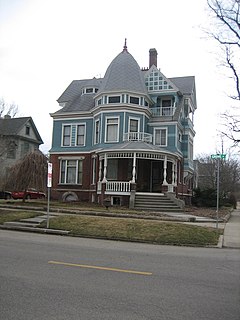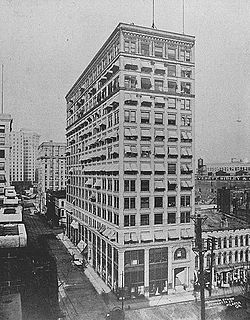
The Magnificent Mile, sometimes referred to as The Mag Mile, is an upscale section of Chicago's Michigan Avenue, running from the Chicago River to Oak Street in the Near North Side. The district is located adjacent to downtown, and one block east of Rush Street. The Magnificent Mile serves as the main thoroughfare between Chicago's Loop business district and its Gold Coast. It is generally the western boundary of the Streeterville neighborhood, to its east and River North to the west.

Washington Crossing Historic Park is a 500-acre (2 km²) state park operated by the Pennsylvania Department of Conservation and Natural Resources in partnership with the Friends of Washington Crossing Park. The park is divided into two sections. One section of the park, the "lower park," is headquartered in the village of Washington Crossing located in Upper Makefield Township in Bucks County, Pennsylvania. It marks the location of George Washington's crossing of the Delaware River during the American Revolutionary War.

The Williamsburgh Savings Bank was a financial institution in Brooklyn, New York from the mid-19th to the mid-20th centuries. The bank was incorporated in 1851 under legislation passed by the New York State Assembly.

The historic Grosse Point Light is located in Evanston, Illinois. Following several shipping disasters near Evanston, residents successfully lobbied the federal government for a lighthouse. Construction was completed in 1873. The lighthouse was added to the National Register of Historic Places on September 8, 1976. On 20 January 1999, the lighthouse was designated a National Historic Landmark. It is maintained under the jurisdiction of the Evanston Lighthouse Park District, an independent taxing authority.

The Century Tower Condominiums, formerly known as the Trustees System Service Building, is a historic building located at 182 West Lake Street in the Loop in Chicago, Illinois.

The George H. Cox House is a historic house located at 701 E. Grove St. in Bloomington, Illinois. It is considered a particularly fine example of the residential work of architect George H. Miller.

The George H. Miller House is a historic house located at 405 W. Market St. in Bloomington, Illinois. Prominent local architect George H. Miller built the house in 1890 for himself and his family. Miller designed many new buildings in downtown Bloomington after a 1900 fire destroyed much of the area; he also served as Superintendent of U.S. Buildings and designed many federal buildings in the Midwest. Miller's house is an eclectic variation on the Queen Anne design. The house features a hexagonal tower on its southeast corner and a conical dormer projecting from the front of the multi-component roof. The front entrance is arched and flanked by columns; small recessed porches are located above the entrance and on the east side of the house. The house has several stained glass windows, including a window with Miller's name at the front entrance and a large circular window on the west side.

In the law regulating historic districts in the United States, a contributing property or contributing resource is any building, object, or structure which adds to the historical integrity or architectural qualities that make the historic district significant. Government agencies, at the state, national, and local level in the United States, have differing definitions of what constitutes a contributing property but there are common characteristics. Local laws often regulate the changes that can be made to contributing structures within designated historic districts. The first local ordinances dealing with the alteration of buildings within historic districts was passed in Charleston, South Carolina in 1931.

The three University of Illinois round barns played a special role in the promotion and popularity of the American round barn. They are located in Urbana Township, on the border of the U.S. city of Urbana, Illinois and on the campus of the University of Illinois at Urbana–Champaign. The University of Illinois was home to one of the Agricultural Experiment Stations, located at U.S. universities, which were at the heart of the promotion of the round barn. At least one round barn in Illinois was built specifically after its owner viewed the barns at the university. Though originally an experiment the three barns helped to lead the way for round barn construction throughout the Midwest, particularly in Illinois. The barns were listed as contributing properties to the U of I Experimental Dairy Farm Historic District, which was listed on the U.S. National Register of Historic Places in 1994.

This is a complete list of National Register of Historic Places listings in Ramsey County, Minnesota. It is intended to be a complete list of the properties and districts on the National Register of Historic Places in Ramsey County, Minnesota, United States. The locations of National Register properties and districts for which the latitude and longitude coordinates are included below, may be seen in an online map.

This is a list of the National Register of Historic Places listings in Crow Wing County, Minnesota. It is intended to be a complete list of the properties and districts on the National Register of Historic Places in Crow Wing County, Minnesota, United States. The locations of National Register properties and districts for which the latitude and longitude coordinates are included below, may be seen in an online map.

The Classen is residential high-rise in the uptown section of Oklahoma City, near the city's Paseo Arts District and Asian District. The tower has 21 floors and is 287 feet tall. It is currently the third tallest residential building in the city. It was listed on the National Register of Historic Places in 2010.

Davenport Bank and Trust Company was for much of the 20th century the leading bank of the Quad Cities metropolitan area and the surrounding region of eastern Iowa and western Illinois. It was at one time Iowa's largest commercial bank, and the headquarters building has dominated the city's skyline since it was constructed in 1927 at the corner of Third and Main Streets in downtown Davenport, Iowa. It was acquired by Norwest Bank of Minneapolis in 1993 and now operates as part of Wells Fargo following a 1998 merger of the two financial institutions. The historic building was listed on the National Register of Historic Places in 1983 under the name of its predecessor financial institution American Commercial and Savings Bank. In 2016 the National Register approved a boundary increase with the Davenport Bank and Trust name. It was included as a contributing property in the Davenport Downtown Commercial Historic District in 2020. It remains the tallest building in the Quad Cities, and is today known as Davenport Bank Apartments as it has been redeveloped into a mixed-use facility housing commercial, office and residential space.

The J. Mack Robinson College of Business Administration Building is a 14-story highrise at the corner of Broad and Marietta streets in the Fairlie-Poplar district of downtown Atlanta, which houses the business school of Georgia State University. When completed in 1901 as the Empire Building, it was the first steel-frame structure and the tallest in the city, until surpassed by the Candler Building in 1906.

The St. Anne Catholic Church in Napoleonville, Louisiana is a historic Roman Catholic church which was built in 1909. It is located about four blocks inland from Bayou Lafourche at 417 St. Joseph Street, as part of a two-block parcel which includes a contributing rectory (1895) and a contributing cemetery, as well as three non-contributing buildings. It was added to the National Register in 2001.

The Jersey County Courthouse, located on 201 W. Pearl Street in Jerseyville, is Jersey County, Illinois' county courthouse. Built in 1893–94, the 124 foot tall courthouse was the third used by the county since its formation in 1839. Architect Henry Elliott of Chicago and Jacksonville designed the building in the Romanesque Revival style. The building's design features a tall central tower topped by an octagonal cupola, terminal towers at the front corners, and a raised front porch. The building's limestone exterior, which is intricately decorated on the front face, uses stone quarried at the nearby city of Grafton. The Jersey County Illinois courthouse was the third courthouse designed by Mr Elliott who also designed the Greene County Courthouse (1891) in Carrollton, Illinois; Edgar County Courthouse (1891) in Paris, Illinois; DeWitt County Illinois Courthouse (1893) in Clinton, Illinois and Pike County Illinois Courthouse (1894) in Pittsfield. The DeWitt County Courthouse was demolished in 1987.

The Old Main, also known as the Livingston C. Lord Administration Building, is the oldest building at Eastern Illinois University in Charleston, Illinois. Construction on the building began in 1896 and was completed in 1899. Architect George H. Miller designed the building, which has a medieval style resembling a castle. The building features a central tower, multiple turrets, and a crenellated roof line. It is one of five medieval buildings built at Illinois' public universities under Illinois Governor John Peter Altgeld's administrations; the buildings are collectively known as Altgeld's castles. The Old Main originally housed all of the offices and classrooms for Eastern Illinois, its library, auditorium, and gymnasium. It was the only building on campus until 1909, when Pemberton Hall opened. The building is now used mainly as an administrative building, though it still contains some classrooms.

The Walnut Grove Farm is a farm complex and historic district located on Knox Station Road 1 mile (1.6 km) north of Knoxville, Illinois. George A. Charles, the son of one of Knoxville's founders, established the farm in 1835. Charles, his sons A.G. and A.P., and A.G.'s son George were all both successful farmers and prominent citizens of Knoxville. The farm focused on breeding cattle and growing corn, with an emphasis on the former; at its peak, the farm covered over 1,900 acres (770 ha), 360 acres (150 ha) of which are included in the historic district. The present farm complex includes a main house, a tenant farmer's house, a bank barn that was once among the largest in the state, three additional barns, a hog farrowing building, and a collection of outbuildings.
Karl Martin Vitzthum (1880-1967) was an American architect.




















